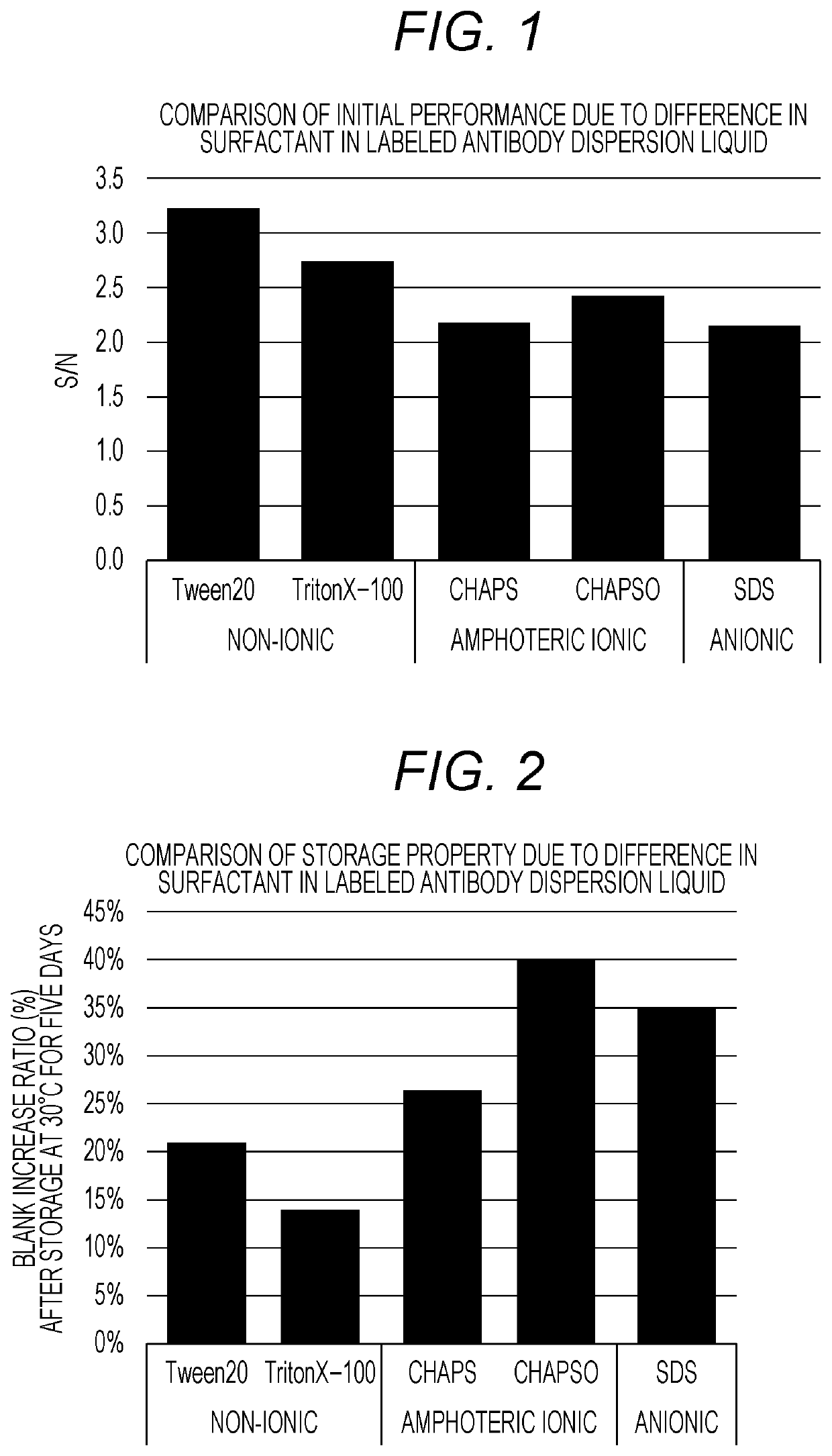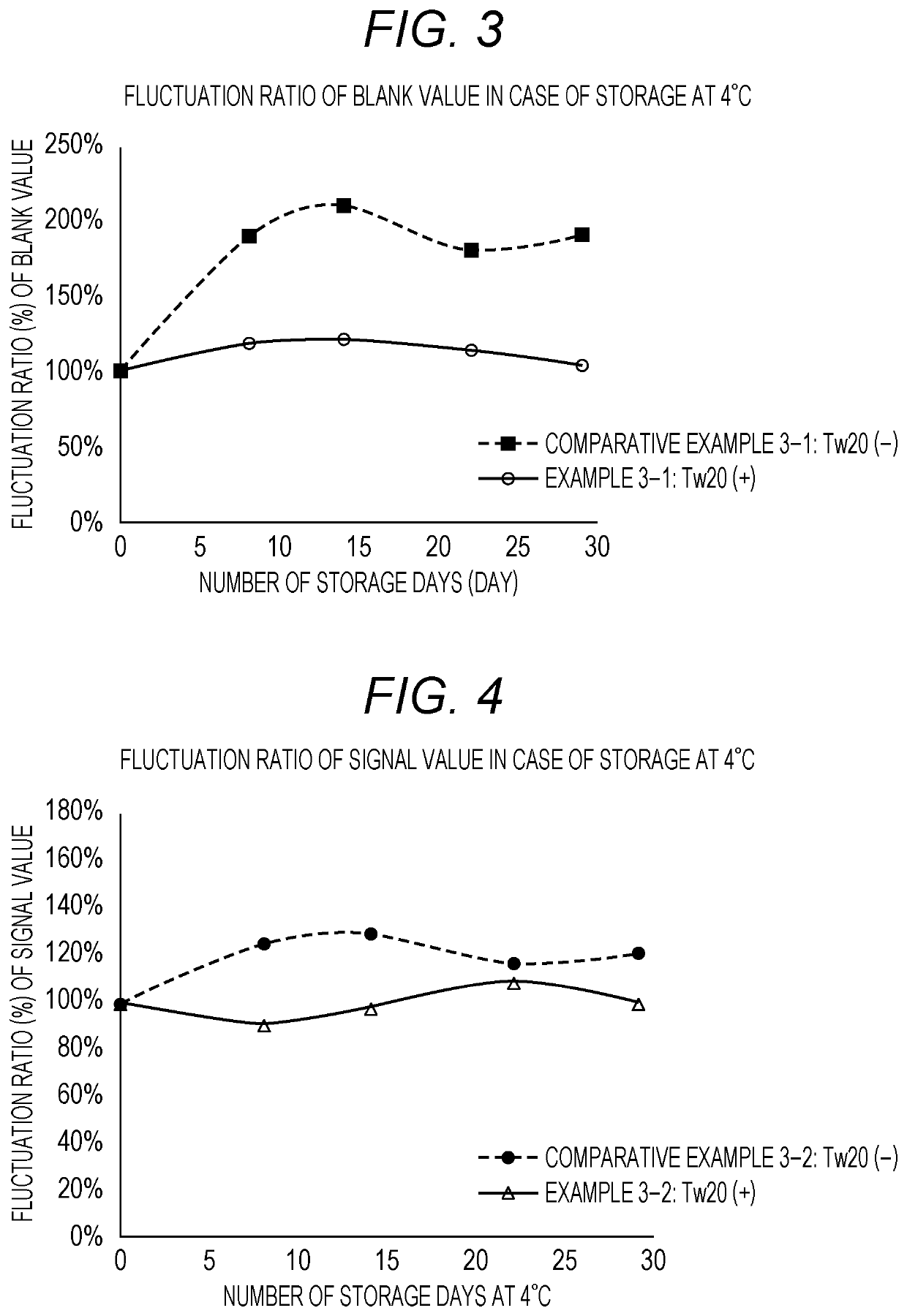Labeled antibody dispersion liquid and kit for spfs
- Summary
- Abstract
- Description
- Claims
- Application Information
AI Technical Summary
Benefits of technology
Problems solved by technology
Method used
Image
Examples
production example 1
[0094]>
[0095]A transparent support made of glass having a refractive index [nd] of 1.72 and a thickness of 1 mm (manufactured by OHARA Inc.: S-LAL 10) was subjected to plasma cleaning, and a chromium thin film was formed on one surface of the support by a sputtering method. Thereafter, a gold thin film, which is a metal member, was further formed on the surface by the sputtering method. The chromium thin film had a thickness of 1 to 3 nm, and the gold thin film had a thickness of 42 to 47 nm.
[0096]The support on which the gold thin film was formed was immersed in 10 mL of an ethanol solution of 10-amino-1-decanethiol prepared to 1 mM for 24 hours to form a measurement area on a surface of the gold thin film. Thereafter, the support was taken out from the ethanol solution, washed with ethanol and isopropanol, and then dried using an air gun.
[0097]>
[0098]The support on which the measurement area was formed was immersed in IVIES buffered saline (IVIES) at pH 7.4 (ionic strength: 10 mM)...
experimental example 1
Example 1 and Comparative Example 1
[0101]>
[0102]A fluorescence-labeled antibody was produced by the following method.
[0103]An anti-cTnI IgG monoclonal antibody (19C7; manufactured by HyTest Ltd.) was dispersed in phosphate buffered saline (PBS) at room temperature, and the concentration thereof was prepared to 1 mg / mL to obtain an antibody dispersion liquid.
[0104]A vial containing a fluorescent dye CF (registered trademark) 660R (manufactured by Biotium) was kept at room temperature, and anhydrous dimethyl sulfoxide (DMSO) was added thereto. The resulting mixture was lightly stirred to cause dispersion, and the concentration thereof was prepared to 10 mM. Then, the remaining undissolved CF (registered trademark) 660R was collected at a bottom of the vial by centrifugation for a short time, and the supernatant was collected to obtain a fluorescent dye dispersion liquid.
[0105]Subsequently, the antibody was reduced. A tris(2-carboxyethyl) phosphine (TCEP) hydrochloride solution prepare...
experimental example 2
Example 2 and Comparative Example 2
[0122]>
[0123]A labeled antibody dispersion liquid was prepared in a similar manner to Experimental Example 1 except that non-ionic surfactants Tween 20 and Triton X-100 were used in the amounts illustrated in Table 3.
[0124]>
[0125]Measurement was performed in a similar manner to Experimental Example 1, and an S / N ratio and a blank increase ratio (%) were calculated from the obtained signal value and blank value.
[0126]Table 3 illustrates the type and concentration of a non-ion surfactant, an initial performance value (S / N ratio), and results of a storage property of each dispersion liquid when the dispersion liquid was stored at 30° C. for five days.
TABLE 3Difference in type of non-ionic surfactant in labeled antibody dispersion liquid and storage propertyConcentrationof surfactantin labeledInitial performanceStorage propertyantibodySignalBlankdispersion(cTnI: 11Blank_0Blank_30° C.increaseNo.SurfactantliquidBlankng / L)S / Nday5 daysratioComparativeTween...
PUM
| Property | Measurement | Unit |
|---|---|---|
| Percent by mass | aaaaa | aaaaa |
| Percent by mass | aaaaa | aaaaa |
| Temperature | aaaaa | aaaaa |
Abstract
Description
Claims
Application Information
 Login to View More
Login to View More - R&D
- Intellectual Property
- Life Sciences
- Materials
- Tech Scout
- Unparalleled Data Quality
- Higher Quality Content
- 60% Fewer Hallucinations
Browse by: Latest US Patents, China's latest patents, Technical Efficacy Thesaurus, Application Domain, Technology Topic, Popular Technical Reports.
© 2025 PatSnap. All rights reserved.Legal|Privacy policy|Modern Slavery Act Transparency Statement|Sitemap|About US| Contact US: help@patsnap.com



